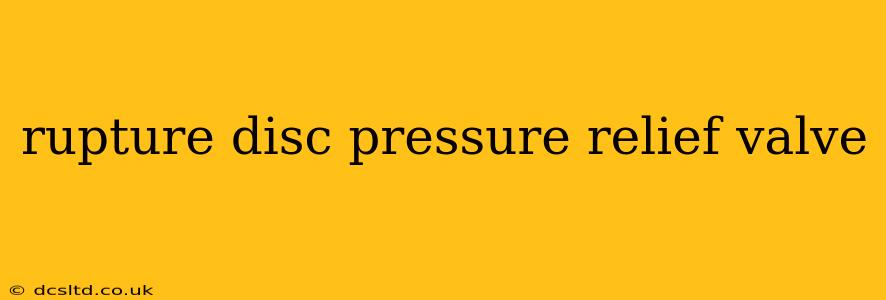Rupture discs and pressure relief valves are critical safety devices used in a wide range of industries to protect process equipment from overpressure. While often used together, they function differently and offer distinct advantages. This comprehensive guide explores rupture disc pressure relief valves, detailing their operation, applications, selection, and maintenance.
What is a Rupture Disc?
A rupture disc, also known as a burst disc or pressure relief disc, is a pressure relief device designed to burst at a predetermined pressure, releasing the contents of a vessel or system. Unlike a valve, it's a one-time use device. Once the rupture disc bursts, it needs to be replaced. They are simple, reliable, and offer a hermetic seal until the pressure exceeds the design limit. This prevents leaks and maintains system integrity until the pressure becomes dangerously high.
How Does a Rupture Disc Pressure Relief Valve System Work?
A rupture disc pressure relief valve system combines the fail-safe nature of a rupture disc with the potential for controlled pressure release offered by a pressure relief valve. The rupture disc acts as the primary pressure relief mechanism. When the system pressure exceeds the rupture disc's rated pressure, the disc bursts, relieving the pressure. A pressure relief valve is often installed downstream. This valve can be set to open at a slightly lower pressure than the rupture disc, providing additional protection and potentially allowing for system depressurization before the disc ruptures. In some configurations, the relief valve is primarily for venting below the rupture disc's pressure, handling normal operational pressure fluctuations. The rupture disc then functions as an ultimate safeguard against catastrophic overpressure.
What are the Different Types of Rupture Discs?
Several types of rupture discs exist, each with unique characteristics suitable for different applications and pressure ranges. These include:
- Reverse Buckling: These discs bulge outwards when pressure exceeds the setpoint, offering a consistent and predictable rupture pressure.
- Forward Buckling: These discs bulge inwards before rupturing, suitable for applications where a slight pressure increase is desired before complete pressure relief.
- Pre-scored: These discs have pre-determined weak points that promote controlled rupture.
- Frictionless: These are designed to minimize friction during rupture, ensuring a quicker and more reliable response.
What are the Advantages of Using a Rupture Disc Pressure Relief Valve System?
Combining a rupture disc with a pressure relief valve offers several compelling advantages:
- Enhanced Safety: Provides redundant protection against overpressure events.
- Hermetic Seal: Prevents leaks and maintains system purity until the rupture pressure is exceeded.
- Reliable Operation: Rupture discs have a simple design with fewer moving parts, leading to increased reliability compared to solely relying on a valve.
- Accurate Pressure Relief: The rupture disc provides precise pressure relief at the predetermined set point.
- Reduced Maintenance: While the disc itself is a single-use component, the overall maintenance requirements of the system might be lower than continuously maintained valves.
What are the Applications of Rupture Disc Pressure Relief Valve Systems?
Rupture disc pressure relief valve systems find widespread applications across various industries, including:
- Chemical Processing: Protecting reactors, distillation columns, and storage tanks from overpressure.
- Pharmaceutical Manufacturing: Maintaining sterile conditions while ensuring safety.
- Oil and Gas: Protecting pipelines, compressors, and storage vessels.
- Food and Beverage: Preserving product quality and safety.
- Aerospace: Protecting critical components and systems.
How to Select the Right Rupture Disc Pressure Relief Valve System?
Selecting the appropriate system involves careful consideration of several factors:
- Process Fluid: The chemical compatibility of the disc material with the process fluid is crucial.
- Operating Pressure and Temperature: The rupture disc and valve must be rated to withstand the expected operating conditions.
- Required Flow Capacity: The system must be sized to adequately relieve the pressure during an overpressure event.
- Installation Requirements: The system must be compatible with the existing process equipment.
How Often Should a Rupture Disc be Replaced?
Rupture discs are single-use devices and must be replaced after they have ruptured. Regular inspection and preventive maintenance programs should be in place to identify potential issues and ensure timely replacement. The frequency of replacement will depend on the specific application and operational parameters.
What is the Cost of a Rupture Disc Pressure Relief Valve System?
The cost varies significantly based on the size, materials, and complexity of the system. It's important to obtain quotes from multiple suppliers to determine the appropriate cost for a specific application.
How Does a Rupture Disc Differ From a Pressure Relief Valve?
A key difference is that a rupture disc is a passive device that bursts at a predetermined pressure, while a pressure relief valve is an active device that opens and closes based on pressure changes. Rupture discs offer a hermetic seal until they rupture, while pressure relief valves may have minor leaks.
This comprehensive guide provides a detailed overview of rupture disc pressure relief valve systems. Remember, proper selection, installation, and maintenance are critical for ensuring the safety and reliability of these vital safety devices. Consult with qualified engineering professionals for specific applications and to ensure compliance with relevant safety regulations.
